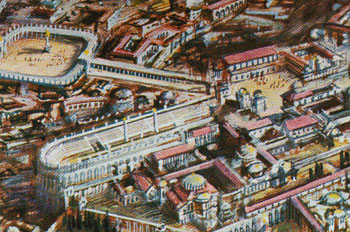 Contents -
Previous Article -
Next Article
Contents -
Previous Article -
Next Article
The Bosporus is a narrow strait separating the continents of Europe and Asia, and Byzantium was located on a tongue shaped peninsula projecting out toward the east from the European side. Ever since earliest recorded history, this has been a place through which much of the land trade between the two continents has passed. Additionally, all the water borne trade and transportation between the Black Sea and the Mediterranean Sea had to sail right by the tip of this peninsula. On the opposite Asian side of the Bosporus lay the city of Chalcedon, also founded by Greek colonists. Byzantium, however, possessed one great advantage over Chalcedon. A fine long natural harbor meanders its way into the European side north of Byzantium. This was the Golden Horn, offering protection for ships in stormy weather and an ideal anchorage for a large navy. It will never be known whether the founders of Chalcedon just didn’t notice this most valuable of assets or whether they had no idea of its importance, but Chalcedon is remembered by those students who delve into the nooks and crannies of history. Constantinople, on the other hand, is known to every school child as one of the most important, powerful, and magnificent cities of all time.
The Roman emperor Constantine saw these advantages and exploited them to good advantage. He totally rebuilt the city early in the Fourth Century A. D. and celebrated its founding as the new modern capital of the Roman Empire on May 11, A. D. 330. His successors, the later Eastern Roman and Byzantine emperors built on Constantine’s vision and made Constantinople the gateway between East and West. Guarded by a powerful navy, technologically up to date for its time, Constantinople was the seat of Byzantine military and economic power.
We can only begin to experience the magnificence of this amazing city by comparing it with our own cities. One must remember that this city had police and fire protection, wide colonnaded streets and government help for the poor during a period when most of Europe lived in small, cramped, walled cities that were regularly ravaged by fire and plague. From the time of its founding until its fall to the Ottoman Empire in A. D. 1453, Constantinople was the pride of the Romans as well as the Byzantines, who referred to themselves as "Romans" even at this late date.
The image at the top of the page is a small detail of a painting that shows how the Constantinople probably looked around the year 1000 A.D. The large oval structure near the bottom left of the photograph is the Hippodrome, where the young show girl Theodora danced before the emperor Justinian, who was so enchanted with her that he eventually broke his own laws and married her. Part of the Imperial Palace can be seen at the upper right of the photo.
Go to next article:
Go back to previous article: